Chinese New Year is a vibrant celebration filled with rich traditions and customs. Explore key festivities like reunion dinners and lion dances, discover the significance of red envelopes, and learn photography techniques to capture these colorful events. Enhance your understanding of cultural variations in celebrations across different regions while mastering how to photograph the essence of this joyous occasion.
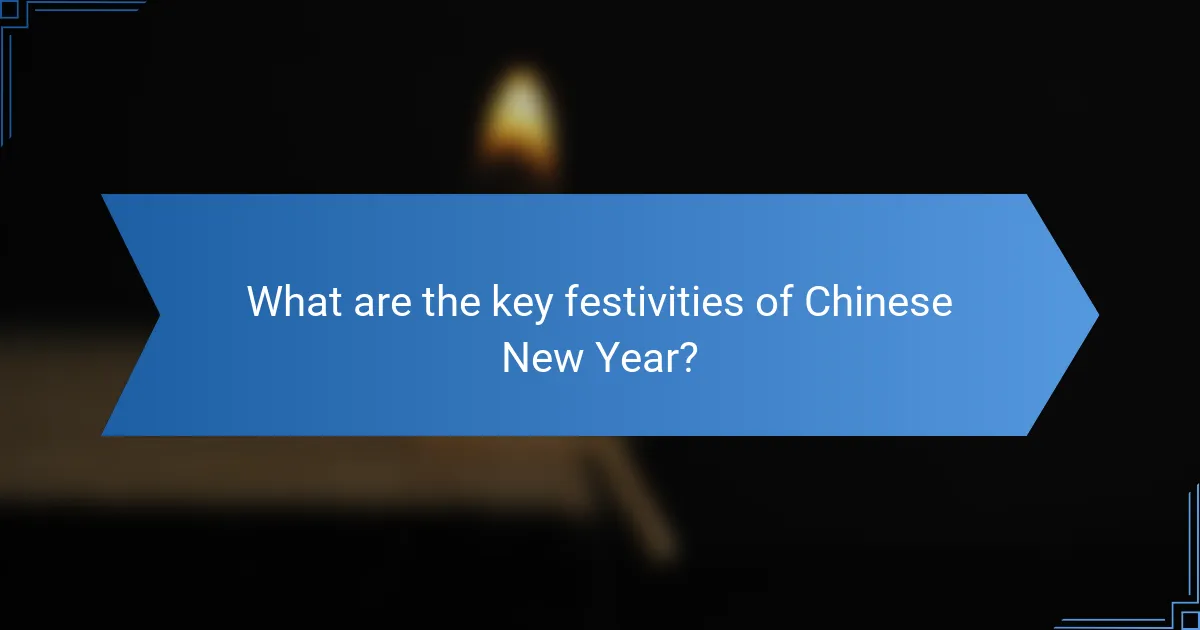
What are the key festivities of Chinese New Year?
Chinese New Year features key festivities that include family reunions, elaborate feasts, and vibrant parades. These celebrations emphasize tradition and cultural heritage.
1. Reunion Dinner: Families gather for a lavish meal on New Year’s Eve, symbolizing unity.
2. Lion and Dragon Dances: Performances that ward off evil spirits and bring good luck.
3. Fireworks: Set off to celebrate the new year and scare away negativity.
4. Red Envelopes: Gifts of money given in red packets to symbolize prosperity.
5. Temple Visits: Families visit temples to pray for good fortune in the upcoming year.
How do different regions celebrate Chinese New Year?
Chinese New Year celebrations vary significantly across regions. In China, families gather for reunion dinners, while in Vietnam, Tết is marked with special foods and ancestral worship. In Malaysia, colorful parades and lion dances are common, whereas in Singapore, the festive atmosphere includes street markets and fireworks. Each region showcases unique customs, reflecting local cultures and traditions.
What are the traditional foods associated with the celebrations?
Traditional foods associated with Chinese New Year include dumplings, fish, rice cakes, and spring rolls. These dishes symbolize prosperity, unity, and good fortune. Dumplings represent wealth, while fish signifies abundance. Rice cakes symbolize progress, and spring rolls stand for wealth. Each dish plays a vital role in the festive celebrations.
Why is the reunion dinner significant during Chinese New Year?
The reunion dinner is significant during Chinese New Year as it symbolizes family unity and the importance of togetherness. Families gather to share a meal, reflecting their gratitude and hopes for the coming year. This tradition emphasizes the values of respect, love, and harmony. The dinner often features specific dishes, each carrying symbolic meanings, such as fish for abundance and dumplings for wealth. This gathering fosters strong familial bonds and cultural heritage, making it a cornerstone of the festivities.
Which cultural performances are commonly featured in the festivities?
Chinese New Year festivities commonly feature traditional performances such as lion dances, dragon dances, and various forms of Chinese opera. These cultural expressions celebrate heritage and bring communities together.
Lion dances involve performers mimicking a lion’s movements in a costume, symbolizing good luck and fortune. Dragon dances, characterized by a long, flexible dragon figure, require multiple dancers and are believed to bring rain and good harvests. Chinese opera showcases elaborate costumes and storytelling through music and movement, often highlighting historical tales and moral lessons.
These performances not only entertain but also reinforce cultural identity and traditions during the celebrations.

What customs are integral to Chinese New Year?
Chinese New Year customs include family reunions, red envelope giving, and traditional foods. These practices symbolize prosperity, good luck, and unity. Families gather for reunion dinners, featuring dishes like dumplings and fish. Red envelopes, filled with money, are exchanged to wish recipients wealth and happiness. Additionally, decorations like lanterns and couplets enhance festive spirits.
How do families honor their ancestors during this time?
Families honor their ancestors during Chinese New Year through various customs and rituals. These include setting up ancestral altars, offering food, and burning incense. Families may also participate in ancestral worship ceremonies, which express gratitude and respect. Additionally, sharing stories about ancestors strengthens family bonds and preserves cultural heritage.
What role do red envelopes play in the celebrations?
Red envelopes play a significant role in Chinese New Year celebrations by symbolizing good luck and prosperity. Traditionally, they contain money and are given to children and unmarried adults, reinforcing family bonds and sharing blessings. The color red is significant as it represents happiness and good fortune. The practice of giving red envelopes, known as “hongbao,” is deeply rooted in Chinese culture, often accompanied by well-wishes for health and success in the coming year.
Why is cleaning the house important before the New Year?
Cleaning the house before the New Year is crucial for welcoming positive energy and good fortune. This ritual symbolizes a fresh start, allowing families to clear away the old and make space for new beginnings. It aligns with customs that emphasize renewal and preparation for the festivities ahead. A clean home enhances the celebratory atmosphere, making it inviting for family gatherings and traditional activities.
What are the symbolic meanings of common decorations?
Chinese New Year decorations symbolize prosperity, happiness, and good fortune. Common items like red lanterns represent joy, while couplets express wishes for the new year. The color red is prominent, symbolizing luck and warding off evil spirits. Gold accents signify wealth and abundance, enhancing the festive atmosphere.
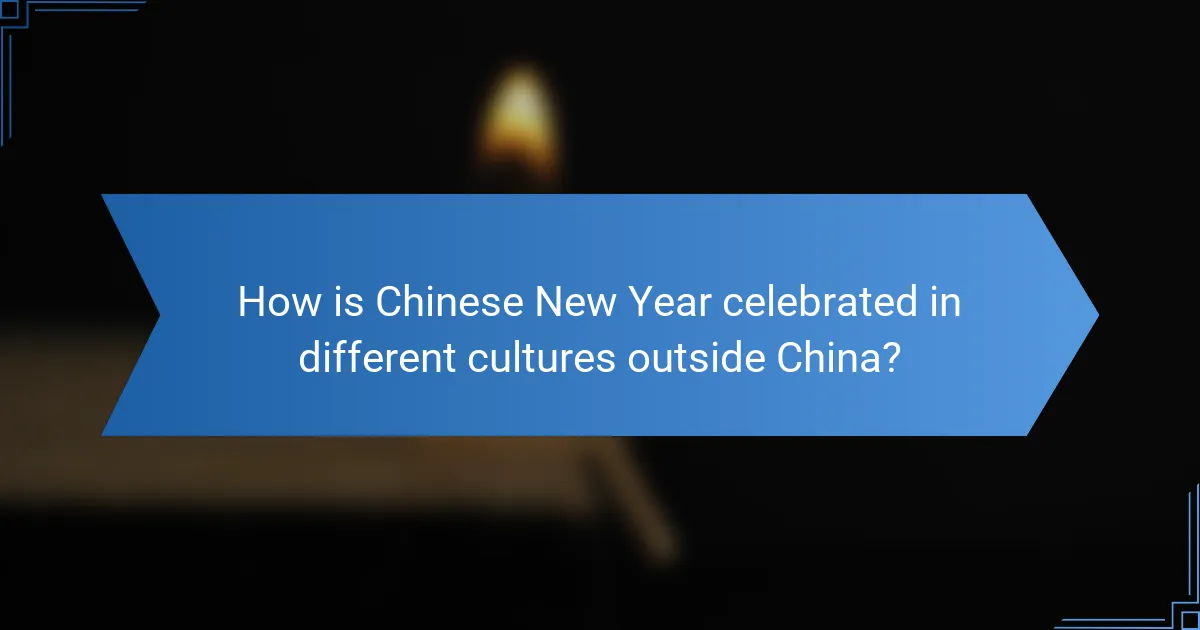
How is Chinese New Year celebrated in different cultures outside China?
Chinese New Year is celebrated in various cultures outside China with unique customs and festivities. In places like Vietnam, it is known as Tet and includes family reunions and special meals. In Singapore, vibrant parades and fireworks mark the occasion, showcasing multicultural influences. In Malaysia, the festival features lion dances and open houses, emphasizing community spirit. Each culture adapts traditional practices, enriching the celebration while maintaining the essence of the Lunar New Year.
What adaptations have occurred in Western celebrations of Chinese New Year?
Western celebrations of Chinese New Year have adapted to include local customs and cultural influences. Festivities now often feature parades, fireworks, and community gatherings that reflect a blend of traditional Chinese practices and Western elements. For example, the incorporation of Western foods and music has become common in many celebrations. Additionally, photography techniques have evolved, with many capturing the vibrant colors and dynamic movements of the celebrations, enhancing the visual storytelling of the event. This adaptation showcases the unique cultural fusion that emerges during Chinese New Year in Western contexts.
How do Southeast Asian countries uniquely celebrate the holiday?
Southeast Asian countries celebrate Chinese New Year with vibrant and unique customs. In Malaysia, lion dances and fireworks are prominent, while Singapore features elaborate street parades. Vietnam celebrates with Tet, emphasizing family reunions and traditional foods. Indonesia showcases cultural performances and temple visits. The Philippines incorporates festive street parties and community gatherings. Each country blends local traditions with Chinese heritage, creating a rich tapestry of celebration.
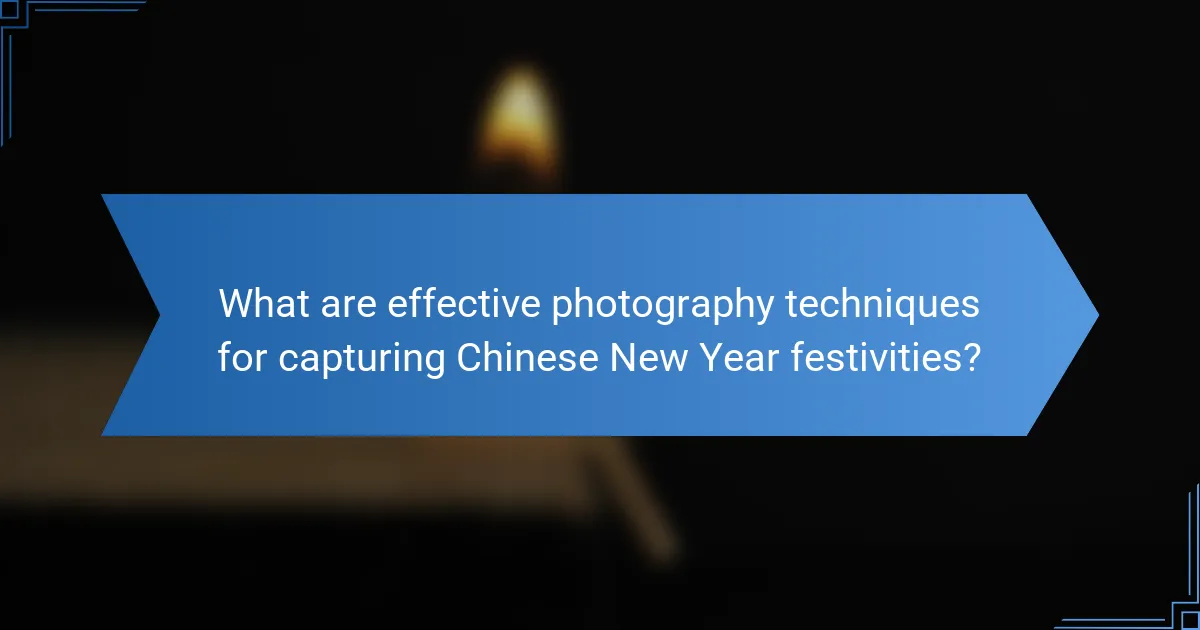
What are effective photography techniques for capturing Chinese New Year festivities?
To effectively capture Chinese New Year festivities, utilize techniques that highlight vibrant colors and dynamic movements. Focus on key moments such as dragon dances, lantern displays, and family gatherings.
Use a fast shutter speed to freeze action during performances. Experiment with low light settings to enhance the glow of lanterns and fireworks. Incorporate wide-angle shots to capture large crowds and festive decorations.
Consider shooting during the golden hour for warm, natural lighting. Use a tripod for stability during nighttime events to prevent blurriness. Lastly, engage with subjects to capture candid expressions that reflect the joy of the celebration.
Which camera settings are best for low-light conditions during night celebrations?
Use a wide aperture, high ISO, and slow shutter speed for optimal low-light photography during night celebrations. A wide aperture (f/1.8 or lower) allows more light, while a high ISO (1600-3200) captures details in dim conditions. A slower shutter speed (1/30s or slower) helps gather light but requires steady hands or a tripod to avoid blur.
How can photographers effectively capture the vibrancy of the parades?
Photographers can effectively capture the vibrancy of parades by focusing on dynamic compositions and vibrant colors. Use fast shutter speeds to freeze motion and highlight the energy of performers. Experiment with angles to showcase the parade’s scale and detail. Incorporate close-ups of costumes and expressions to convey emotions. Timing is crucial; shoot during peak moments for maximum impact.
What tips can enhance the storytelling aspect of Chinese New Year photography?
To enhance the storytelling aspect of Chinese New Year photography, focus on capturing emotions, traditions, and vibrant colors. Use natural light to highlight details and create depth.
Incorporate cultural symbols like lanterns and red envelopes to convey significance. Engage with subjects, encouraging candid moments that reflect joy and connection.
Experiment with different angles and compositions to tell a unique story. Consider using props or traditional attire to add context and richness to your images.
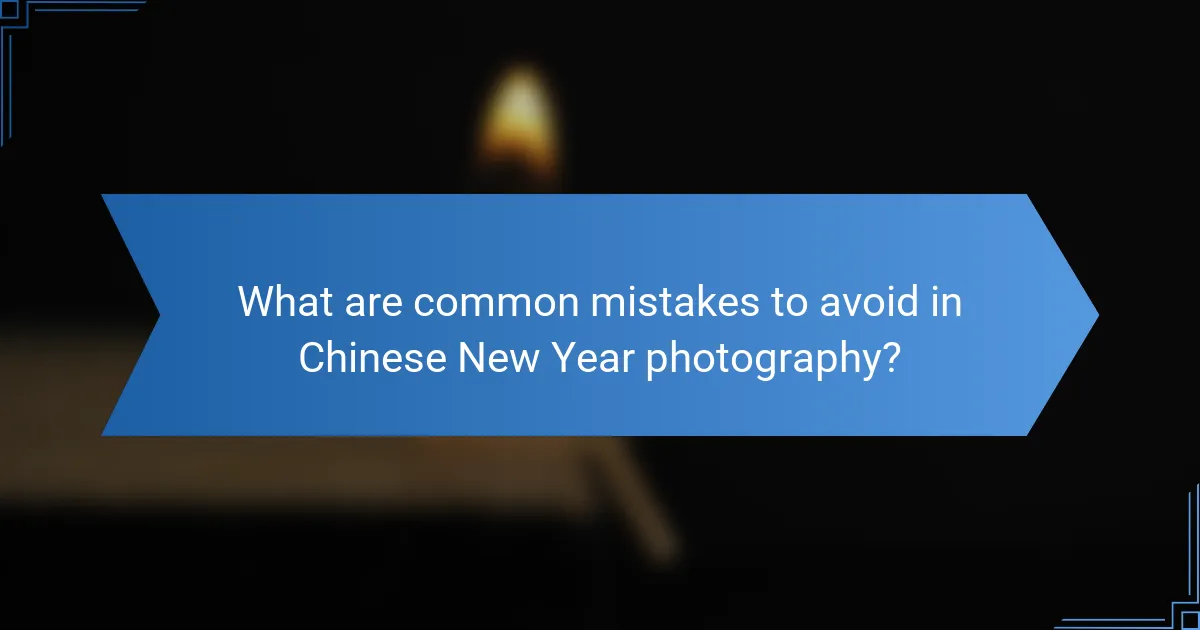
What are common mistakes to avoid in Chinese New Year photography?
Common mistakes to avoid in Chinese New Year photography include poor lighting, lack of preparation, and ignoring cultural significance.
Many photographers underestimate the importance of natural light during celebrations. Capturing vibrant colors and intricate details requires careful planning. Failing to understand customs can lead to missed opportunities for meaningful shots.
Not considering composition can result in cluttered images. Avoid distractions in the background to highlight festive elements. Lastly, neglecting to engage with subjects can lead to stiff, uninviting photos. Aim for candid moments that reflect the joy of the occasion.
How can one ensure cultural sensitivity when photographing traditions?
To ensure cultural sensitivity when photographing traditions, research the significance of customs and engage with community members. Understand local values and seek permission when capturing images. This approach fosters respect and authenticity, particularly during events like Chinese New Year, where traditions hold deep meaning. Engaging with participants enhances the photography experience and promotes a positive representation of cultural practices.
What are the best practices for photographing food during the celebrations?
To photograph food during Chinese New Year celebrations effectively, focus on lighting, composition, and cultural elements. Use natural light to enhance colors and textures. Arrange dishes attractively, considering the rule of thirds for composition. Incorporate traditional decorations, like red lanterns or gold accents, to convey the festive spirit. Experiment with angles, capturing both close-ups and wider shots for variety.
How to prepare for unpredictable weather conditions during outdoor events?
To prepare for unpredictable weather during outdoor events, plan for various scenarios. Ensure you have contingency measures in place, such as tents or canopies for shelter, and provide attendees with information on weather forecasts.
Consider the following preparations:
1. Monitor weather forecasts regularly leading up to the event.
2. Provide adequate shelter options for guests.
3. Have a supply of rain gear, such as ponchos or umbrellas.
4. Ensure access to indoor facilities if needed.
5. Communicate any changes in plans promptly to attendees.
By taking these steps, you can enhance the experience despite unexpected weather changes.
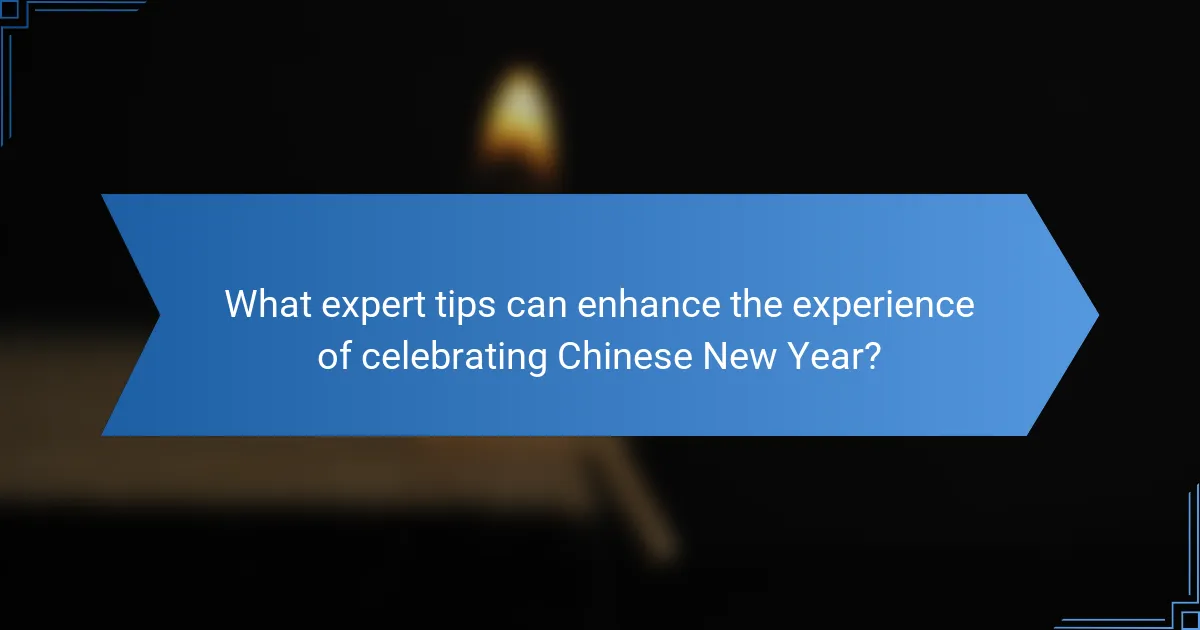
What expert tips can enhance the experience of celebrating Chinese New Year?
To enhance the experience of celebrating Chinese New Year, focus on traditions, decorations, and photography techniques. Incorporate vibrant decorations like lanterns and couplets to create a festive atmosphere. Engage in traditional customs such as family reunions and special meals, emphasizing the importance of unity and prosperity. For photography, capture the essence of the celebrations by using natural light and focusing on candid moments. Experiment with angles to highlight cultural elements, ensuring memories are preserved beautifully.
How to create a memorable reunion dinner atmosphere?
To create a memorable reunion dinner atmosphere for Chinese New Year, focus on ambiance, food presentation, and meaningful decorations.
Start by setting the table with vibrant colors, using traditional red and gold tableware to symbolize good fortune. Incorporate fresh flowers, such as peonies, which represent prosperity.
Serve a variety of dishes, ensuring they are visually appealing and arranged thoughtfully. Include symbolic foods like fish for abundance and dumplings for wealth.
Finally, use soft lighting and traditional music to enhance the atmosphere, creating a warm and inviting space for family connections.
What are the best ways to engage with local communities during celebrations?
Engaging with local communities during Chinese New Year celebrations can enhance cultural appreciation and foster connections. Participate in local parades, volunteer at community events, or host photography workshops that highlight traditional customs. Collaborate with local artisans to showcase their crafts and encourage community members to share their stories. Create social media campaigns to promote local events and encourage participation.
How to balance tradition and modernity in celebrating Chinese New Year?
Balancing tradition and modernity in celebrating Chinese New Year involves integrating modern practices while honoring age-old customs. Families can maintain traditional rituals, such as family reunions and ancestral worship, while incorporating contemporary elements like digital greetings and modern decorations.
Embrace technology to share experiences through social media, showcasing traditional foods and activities. This fusion allows for a richer celebration that respects heritage while appealing to younger generations.
In photography, capture both traditional scenes, like lion dances, and modern festivities, highlighting the contrast and continuity. This approach preserves cultural significance while adapting to current trends, ensuring that celebrations remain relevant and engaging.